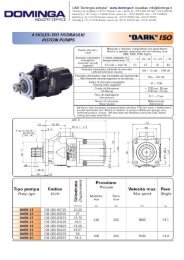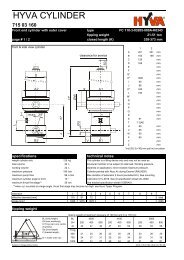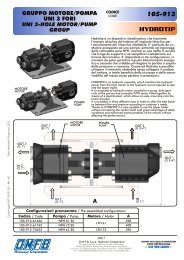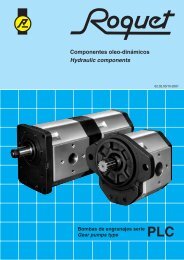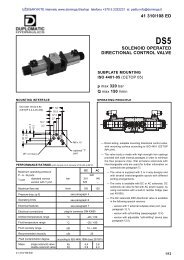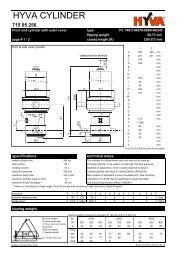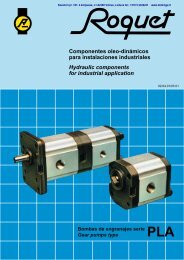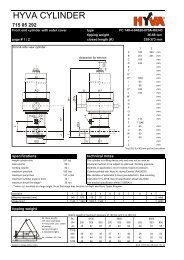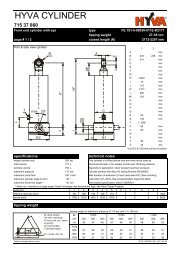Safety Data Sheet - dominga.lt
Safety Data Sheet - dominga.lt
Safety Data Sheet - dominga.lt
Create successful ePaper yourself
Turn your PDF publications into a flip-book with our unique Google optimized e-Paper software.
<strong>Safety</strong> <strong>Data</strong> <strong>Sheet</strong><br />
ACMOS CHEMIE KG according to Regulation (EC) No. 1907/2006<br />
WAXILIT 22-71F<br />
Issue date : 15.12.2011 Page 1 of 17<br />
SECTION 1: Identification of the substance/mixture and of the company/undertaking<br />
Product identifier<br />
WAXILIT 22-71F<br />
Relevant identified uses of the substance or mixture and uses advised against<br />
Relevant identified uses<br />
Lubricant<br />
Uses advised against<br />
The product is for industrial and professional use only - no consumer product.<br />
Details of the supplier of the safety data sheet<br />
Manufacturer<br />
Company name:<br />
Street:<br />
Place:<br />
Post-office box:<br />
ACMOS CHEMIE KG<br />
Industriestrasse 49<br />
D-28199 Bremen<br />
10 10 69<br />
D-28010 Bremen<br />
Telephone: +49 (0)421-5189-0 Telefax:+49 (0)421-511415<br />
e-mail:<br />
Contact person:<br />
Internet:<br />
Responsible Department:<br />
Supplier<br />
Company name:<br />
acmos@acmos.com<br />
Mr. Dryhaus<br />
www.acmos.com<br />
Laboratory (Division : Occupational- / Product security) - See under section 16<br />
ACMOS CHEMIE KG<br />
Street: Industriestrasse 49<br />
Place:<br />
D-28199 Bremen<br />
Post-office box: 10 10 69<br />
D-28010 Bremen<br />
Telephone:<br />
e-mail:<br />
Contact person:<br />
Internet:<br />
+49 (0)421-5189-0 Telefax: +49 (0)421-511415<br />
acmos@acmos.com<br />
Mr. Dryhaus<br />
www.acmos.com<br />
Responsible Department: Laboratory (Division : Occupational- / Product security) - See under section 16<br />
Emergency telephone:<br />
+49 (0)551-19240 (Emergency information service / official advisory body:<br />
Giftinformationszentrum Nord, Universität Göttingen, 24 h service)<br />
SECTION 2: Hazards identification<br />
Classification of the substance or mixture<br />
Classification according to Directive 67/548/EEC or Directive 1999/45/EC<br />
Indications of danger : Harmful<br />
R-phrases:<br />
Flammable.<br />
Harmful to aquatic organisms, may cause long-term adverse effects in the aquatic environment.<br />
Harmful: may cause lung damage if swallowed.<br />
Repeated exposure may cause skin dryness or cracking.<br />
Vapours may cause drowsiness and dizziness.<br />
This preparation is classified as hazardous according to the new EC-preparation directive 1999/45/EC.<br />
Revision no.: 1,13 GB - EN<br />
Revision date: 30.06.2009
<strong>Safety</strong> <strong>Data</strong> <strong>Sheet</strong><br />
ACMOS CHEMIE KG according to Regulation (EC) No. 1907/2006<br />
WAXILIT 22-71F<br />
Issue date : 15.12.2011 Page 2 of 17<br />
Label elements<br />
Danger symbols:<br />
Xn - Harmful<br />
Xn - Harmful<br />
Hazardous components which must be listed on the label<br />
hydrocarbons, C9-C10, n-alkanes, isoalkanes, cyclics,
<strong>Safety</strong> <strong>Data</strong> <strong>Sheet</strong><br />
ACMOS CHEMIE KG according to Regulation (EC) No. 1907/2006<br />
WAXILIT 22-71F<br />
Issue date : 15.12.2011 Page 3 of 17<br />
Hazardous components<br />
EC No.<br />
CAS No.<br />
Index No.<br />
REACH No.<br />
927-241-2<br />
64742-49-0<br />
01-2119471843-32<br />
918-668-5<br />
64742-95-6<br />
01-2119455851-35<br />
Chemical name<br />
Classification<br />
GHS classification<br />
hydrocarbons, C9-C10, n-alkanes, isoalkanes, cyclics,
<strong>Safety</strong> <strong>Data</strong> <strong>Sheet</strong><br />
ACMOS CHEMIE KG according to Regulation (EC) No. 1907/2006<br />
WAXILIT 22-71F<br />
Issue date : 15.12.2011 Page 4 of 17<br />
Never give anything by mouth to an unconscious person.<br />
Most important symptoms and effects, both acute and delayed<br />
See under section 11.<br />
Indication of any immediate medical attention and special treatment needed<br />
Treat symptomatically.<br />
In case of ingestion, the stomach should be emptied by gastric lavage under qualified medical supervision.<br />
Later control for pneumonia and lung oedema.<br />
SECTION 5: Firefighting measures<br />
Extinguishing media<br />
Suitable extinguishing media<br />
Use extinguishing measures that are appropriate to local circumstances and the surrounding environment.<br />
water spray, sand, foam, dry chemical, carbon dioxide (CO2)<br />
Extinguishing media which must not be used for safety reasons<br />
Do not use a solid water stream as it may scatter and spread fire.<br />
Special hazards arising from the substance or mixture<br />
Fire will produce dense black smoke containing hazardous combustion products.<br />
Under conditions giving incomplete combustion, hazardous gases produced may consist of : Carbon monoxide, carbon<br />
dioxide (CO2), hydrocarbons, smoke<br />
In principle, fire gasses of organic materials have to be classified as toxic to the respiratory system.<br />
Advice for firefighters<br />
In the event of fire, wear self-contained breathing apparatus.<br />
In the event of fire and/or explosion do not breathe fumes.<br />
Move to fresh air in case of accidental inhalation of fumes from overheating or combustion.<br />
Additional information<br />
Usual measures of preventive and averting fire protection.<br />
In the event of fire, cool tanks with water spray.<br />
Fire residues and contaminated fire extinguishing water must be disposed of in accordance with local regulations.<br />
Collect contaminated fire extinguishing water separately. This must not be discharged into drains.<br />
SECTION 6: Accidental release measures<br />
Personal precautions, protective equipment and emergency procedures<br />
Avoid contact with skin and eyes. Try to avoid breathing vapours or spray mist.<br />
Remove all sources of ignition. Do not smoke.<br />
Keep people away from and upwind of spill/leak.<br />
Prevent further leakage or spillage if safe to do so.<br />
Ensure adequate ventilation.<br />
For non-emergency personnel :<br />
Walk out of the danger zone and notify trained personnel.<br />
If necessary, wear personal protective equipment. Never enter into a personal risk. See under section 8.<br />
Keep the factory emergency plan and the information chain.<br />
For emergency responders :<br />
The personal protective equipment must be adapted to the situation.<br />
Environmental precautions<br />
Do not flush into surface water or sanitary sewer system.<br />
Methods and material for containment and cleaning up<br />
Clean-up methods - large spillage : Dam up. Shovel into suitable container for disposal. Local authorities should be<br />
advised if significant spillages cannot be contained. Contact the proper local authorities.<br />
Revision no.: 1,13 GB - EN<br />
Revision date: 30.06.2009
<strong>Safety</strong> <strong>Data</strong> <strong>Sheet</strong><br />
ACMOS CHEMIE KG according to Regulation (EC) No. 1907/2006<br />
WAXILIT 22-71F<br />
Issue date : 15.12.2011 Page 5 of 17<br />
Clean-up methods - small spillage : Soak up with inert absorbent material (e.g. sand, silica gel, acid binder, universal<br />
binder, sawdust). Take up mechanically and collect in suitable container for disposal .<br />
Reference to other sections<br />
Further information see under section 8, 13.<br />
SECTION 7: Handling and storage<br />
Precautions for safe handling<br />
Advice on safe handling<br />
Prevent the creation of flammable or explosive concentrations of vapour in air and avoid vapour concentration higher<br />
than the occupational exposure limits. The product should only be used in areas from which all naked lights and other<br />
sources of ignition have been excluded. Use only in well-ventilated areas. When using, do not eat, drink or smoke.<br />
Advice on protection against fire and explosion<br />
Measures according to German "Explosion rules" required :<br />
Prevention measures regarding formation of explosible atmosphere (restriction and supervision of concentration,<br />
inertisation, airtightness, ventilation, warning device, etc.).<br />
Prevention measures regarding ignition of explosible atmosphere (zone graduation, removing of ignition sources,<br />
explosion-proof electrical installation, earthing, etc.).<br />
Constructive measures for restriction of effects regarding explosions (resistance to pressure of explosions, discharge of<br />
pressure of explosions, suppression of explosions, etc.).<br />
Take precautionary measures against static discharges. Preparation may charge electrostatically: always use earthing<br />
leads when transferring from one container to another. To avoid ignition of vapours by static electricity discharge , all<br />
metal parts of the equipment must be grounded. Do not use pressure to empty drums.<br />
Keep product and empty container away from heat and sources of ignition. Do not smoke.<br />
An explosible atmosphere may be build in partially and totally emptied containers.<br />
Vapours may form explosive mixture with air.<br />
Spray mist may be flammable at temperatures below the flash point.<br />
Vapours are heavier than air and may spread along floors.<br />
Electrical equipment should be protected to the appropriate standard.<br />
Fire-fighting equipment on the basis of class B.<br />
Further information on handling<br />
Reference on types of contact requiring special precautionary measures :<br />
Particularly at work places with filling and transfer procedures into other containers, as well as with weightening and<br />
mixture processes an effective exhaust ventilation has to be guaranteed .<br />
For restriction of emission on volatile organic compounds (VOC) the solvent vapours should be supplied to an exhaust<br />
air purification facility (fi<strong>lt</strong>er, gas washer, incineration).<br />
Conditions for safe storage, including any incompatibilities<br />
Requirements for storage rooms and vessels<br />
Keep containers tightly closed in a cool, well-ventilated place.<br />
The valid water and zoning ordinances must be observed.<br />
Design solvent resistant and tight floor.<br />
Advice on storage compatibility<br />
Stable under recommended storage conditions.<br />
Incompatible with oxidising agents.<br />
Further information on storage conditions<br />
Indoor stockability in closed unopened original containers : 18 months.<br />
Store at room temperature in the original container.<br />
Keep at temperatures between +10 and +30 °C.<br />
Do not store outside. Avoid heating and direct sunlight.<br />
See also instuctions on the label.<br />
Specific end use(s)<br />
Possibilities for substitution and references to less hazardous products :<br />
Revision no.: 1,13 GB - EN<br />
Revision date: 30.06.2009
<strong>Safety</strong> <strong>Data</strong> <strong>Sheet</strong><br />
ACMOS CHEMIE KG according to Regulation (EC) No. 1907/2006<br />
WAXILIT 22-71F<br />
Issue date : 15.12.2011 Page 6 of 17<br />
This product was designed for a special application purpose and optimized appropriately.<br />
In case of questions regarding product and application, please contact our field service in line with customer service or<br />
our technical sales department.<br />
Specific regulations of branch industries :<br />
Hazardous substance information systems of professional associations.<br />
SECTION 8: Exposure controls/personal protection<br />
Control parameters<br />
Additional advice on limit values<br />
Recommended monitoring and observation processes : None known.<br />
Control banding for chemicals according to the ILO CHEMICAL CONTROL TOOLKIT (ICCT) :<br />
ICCT-Guidelines and - Control Guidance <strong>Sheet</strong>s :<br />
http://www.ilo.org/legacy/english/protection/safework/ctrl_banding/toolkit/main_guide.pdf<br />
Consider appropriate model solutions according to good engineering practices on designing the working process, if<br />
available.<br />
Exposure controls<br />
Appropriate engineering controls<br />
Design of appropriate work processes and engineering controls and the use of adequate materials (closed systems with<br />
gas-displacement, physical cut-off of man and machine, model solutions as certified working methods, working appliance<br />
according to the state of the art, optimization of process / spray robots, working appliance for prevention of skin contact,<br />
models of working times).<br />
Preliminary concentration measurements :<br />
Suitable detector tubes for measuring the current concentration in the air at the workplace : DRÄGER test tubes -<br />
short-term tubes (Internet : http://www.gasmesstechnik.de)<br />
References for design of technical equipment : See under section 7.<br />
Execution of collective protection measures at source and appropriate organisational measures (local exhaust<br />
ventilation, ventilation by technical means, general ventilation, measures on averting a danger at breakdowns / at<br />
emergencies / after accidents, first-aid-measures, manner related measures : operating instruction / instruction of<br />
employees, occupational medicine hea<strong>lt</strong>h precaution).<br />
Provide appropriate exhaust ventilation at machinery. Where reasonably practicable this should be achieved by the use<br />
of local exhaust ventilation and good general extraction. If these are not sufficient to maintain concentrations of<br />
particulates and solvent vapour below the OEL, suitable respiratory protection must be worn.<br />
Execution of individual and personnel protection measures (personal protective equipment - PPE).<br />
Individual protection measures, such as personal protective equipment<br />
When using, do not eat, drink or smoke. General industrial hygiene practice.<br />
Handle in accordance with good industrial hygiene and safety practice.<br />
Respiratory protection<br />
Breath protection at insufficient ventilation or prolonged exposition . Observe limited carrying time. The use of fi<strong>lt</strong>er<br />
equipment requires a minimum oxygen content of 17 Vol-% in the surrounding atmosphere and that the maximum<br />
permitted gas concentration - normally 0,5 Vol-% - is not exceeded.<br />
Half mask or quarter mask with combination fi<strong>lt</strong>er A1P1/A2P2 for gases, vapors and particles.<br />
Revision no.: 1,13 GB - EN<br />
Revision date: 30.06.2009
<strong>Safety</strong> <strong>Data</strong> <strong>Sheet</strong><br />
ACMOS CHEMIE KG according to Regulation (EC) No. 1907/2006<br />
WAXILIT 22-71F<br />
Issue date : 15.12.2011 Page 7 of 17<br />
Fi<strong>lt</strong>ering half mask or quarter mask with combination fi<strong>lt</strong>er FFA1 P1/FFA2P2 for gases, vapors and particles. (EN 405)<br />
Gas fi<strong>lt</strong>rating Half-face mask FFA (EN 405)<br />
Model 4251 (FFA1P1 - 1000 ml/m3) / 4255 (FFA2P2SL - 5000 ml/m3) - 3M, Internet : http://www.3m.com<br />
Half-face mask or Quarter-face mask with gas fi<strong>lt</strong>er (EN 140)<br />
Fi<strong>lt</strong>er type 6051 (A1 - 1000 ml/m3) / 6055 (A2 - 5000 ml/m3) - 3M, Internet : http://www.3m.com<br />
Full-face mask with gas fi<strong>lt</strong>er (EN 136)<br />
Gas fi<strong>lt</strong>er type : A, Indication colour : brown<br />
Skin protection<br />
Hand protection :<br />
Use only chemical protective gloves with CE-status of category III in accordance to EN 374. Suitable materials at long<br />
term, direct contact (Recommended : Preventive index 6, accordingly > 480 min. permeation time in accordance to EN<br />
374) :<br />
Fluorine rubber / FKM / Viton (VITOJECT® - Art. No. 890) - Layer thickness : 0,7 mm<br />
Nitrile rubber / NBR (CAMATRIL VELOURS® - Art. No. 730) - Layer thickness : 0,4 mm<br />
Suitable materials at short term contact or splash (Recommended : Preventive index 3, accordingly > 60 min. permeation<br />
time in accordance to EN 374) :<br />
Disposable gloves of special nitrile rubber / NBR (DERMATRIL® P - Art. No. 743) - Layer thickness : 0,2 mm<br />
Manufacturer :<br />
Kächele-Cama Latex GmbH, Industriepark Röhn, Am Kreuzacker 9, D-36124 Eichenzell, c/ o Tony O'Donovan, 2<br />
Wyndham Road, New Wa<strong>lt</strong>ham, Grimsby, N. E. Lincs, GB-DN36 4WA<br />
Telephone : +44-(0)1472232883, Telefax : +44-(0)1472232883, Internet : http://www.kcl.de, E-Mail : kcl-uk@kcl.de<br />
The statements are based on self-tests, literary reference and information of glove manufacturers or have been derived<br />
from similar substances by analogy. Source : CHEMIKALIEN-MANAGER - KCL software for hand protection. It has to be<br />
noticed, that daily time of use of chemical protective gloves may be quite shorter in practice because of many factors of<br />
influence (e.g. thermal and mechanical stress as well as special conditions on the floor) than the permeation time<br />
determined in accordance to EN 374. The respective permeation time doubles/halvens at about 1,5 times larger/lower<br />
layer thickness. Declared permeation times according to EN 374 are not carried out under practical conditions. Therefore<br />
a maximum wearing time up to 50 % of breakthrough time is recommended. They relate to the pure solvent as mean<br />
component.<br />
Decrease wearing protection gloves to an inevitable degree to avoid skin rash. Technical and organizational protective<br />
actions have to be preferred. Wear under gloves made of cotton as possible. Change preventive gloves once by hour or<br />
use special skin-protective preparations for protective gloves carrier, e.g. physioderm® proGlove<br />
Before removing gloves clean them with soap and water. Dispose preventive gloves after defect or expiry of wearing<br />
time. Check protective gloves to proper condition before usage.<br />
Preventive skin protection. : Draw up skin protection programme.<br />
Before starting work, apply solvent-resistant skincare preparations,<br />
e.g. sansibal® / sansibon®, dualin®<br />
Wash hands before breaks and on finishing work,<br />
e.g. ecosan®, topscrub® soft / topscrub® extra / topscrub® nature<br />
After cleansing, apply greasy skincare products,<br />
e.g. physioderm® creme, cura soft® / cUrea soft®<br />
Manufacturer :<br />
Peter Greven Physioderm GmbH, Procter-&-Gamble-Str. 26, D-53881 Euskirchen<br />
Telephone : +49-(0)2251 77617-61, Telefax : +49-(0)2251 77617-44, Internet : http://www.physioderm.de, E-Mail :<br />
info@physioderm.de<br />
Other :<br />
Skin protection :<br />
lightweight protective clothing (EN 340),<br />
Revision no.: 1,13 GB - EN<br />
Revision date: 30.06.2009
<strong>Safety</strong> <strong>Data</strong> <strong>Sheet</strong><br />
ACMOS CHEMIE KG according to Regulation (EC) No. 1907/2006<br />
WAXILIT 22-71F<br />
Issue date : 15.12.2011 Page 8 of 17<br />
antistatic boots (EN 344)<br />
Eye / face protection<br />
safety glasses with side-shields (EN 166)<br />
Thermal hazards<br />
No thermal hazards during use of this product.<br />
Environmental exposure controls<br />
Should not be released into the environment. Discharge exhaust air only with suitable seperators to atmosphere.<br />
Further information see under section 6.<br />
SECTION 9: Physical and chemical properties<br />
Information on basic physical and chemical properties<br />
Physical state:<br />
Colour:<br />
Odour:<br />
pH-Value:<br />
Changes in the physical state<br />
Me<strong>lt</strong>ing point:<br />
Boiling point:<br />
Sublimation point:<br />
Softening point:<br />
Flash point:<br />
liquid<br />
light yellow<br />
characteristic<br />
Not applicable<br />
not determined<br />
Test method<br />
> 140 °C Literary reference<br />
Not applicable<br />
not determined<br />
> 24 °C<br />
EN ISO 2719<br />
Explosive properties<br />
In use, may form flammable/explosive vapour-air mixture. The statements for steam pressure, ignition point and<br />
explosion levels apply to the solvent / solvent mixture.<br />
Lower explosion limits:<br />
Upper explosion limits:<br />
Ignition temperature:<br />
Oxidizing properties<br />
Not applicable<br />
0,6 vol. %<br />
7,0 vol. %<br />
> 200 °C<br />
Literary reference<br />
Literary reference<br />
Literary reference<br />
Vapour pressure:<br />
< 5 hPa Literary reference<br />
(at 20 °C)<br />
Vapour pressure:<br />
< 24 hPa Literary reference<br />
(at 50 °C)<br />
Density (at 20 °C): 0,8 g/cm³ DIN 51757<br />
Water solubility:<br />
(at 20 °C)<br />
Solubility in other solvents:<br />
Partition coefficient:<br />
Viscosity / dynamic:<br />
Viscosity / kinematic:<br />
(at 23 °C)<br />
Flow time:<br />
(at 23 °C)<br />
Vapour density:<br />
(at 25 °C)<br />
miscible with most organic solvents<br />
Not applicable (Preparation)<br />
< 0,1 g/L Literary reference<br />
not determined<br />
< 7 mm²/s<br />
23 s<br />
~4.0 (Air=1), M~126 g/mol<br />
3 EN ISO 2431<br />
3 EN ISO 2431<br />
Literary reference<br />
Revision no.: 1,13 GB - EN<br />
Revision date: 30.06.2009
<strong>Safety</strong> <strong>Data</strong> <strong>Sheet</strong><br />
ACMOS CHEMIE KG according to Regulation (EC) No. 1907/2006<br />
WAXILIT 22-71F<br />
Issue date : 15.12.2011 Page 9 of 17<br />
Evaporation rate:<br />
(at 20 °C)<br />
Solvent separation test:<br />
Solvent content:<br />
Other information<br />
Solid content:<br />
< 0.6 (n-BuAc=1)<br />
Not applicable<br />
not determined<br />
not determined<br />
ASTM D 3539<br />
Gas group (94/9/EC) : IIA (maximum experimental safe gap > 0,9 mm)<br />
Temperature class (94/9/EC) : T3 (T > 200 °C ...
<strong>Safety</strong> <strong>Data</strong> <strong>Sheet</strong><br />
ACMOS CHEMIE KG according to Regulation (EC) No. 1907/2006<br />
WAXILIT 22-71F<br />
Issue date : 15.12.2011 Page 10 of 17<br />
May cause skin irritation in susceptible persons. Repeated or prolonged contact with the preparation may cause removal<br />
of natural fat from the skin resu<strong>lt</strong>ing in non-allergic contact dermatitis and absorption through the skin. Solvents may<br />
degrease the skin.<br />
After eye contact :<br />
Contact with eyes may cause irritation.<br />
High concentration of vapours may cause irritation to eyes and respiratory system and produce narcotic effects .<br />
Delayed and immediate effects as well as chronic effects from short and long -term exposure :<br />
Not relevant / no data available<br />
Interactive effects :<br />
Not relevant / no data available<br />
Absence of specific data :<br />
No data is available on the product itself. Description of possible hazardous to hea<strong>lt</strong>h effects is based on experience<br />
and/or toxicological characteristics of several components.<br />
Based on manufacturer datas of the main components the acute toxixity, the skin irritation, the mucous membrane<br />
irritation and the mutagenic potential of the preparation were evaluated. However, some datas are not complete<br />
regarding particular main components. Nevertheless according to the experience of the manufacturer there are no other<br />
hazards expected then those which are already mentioned on the label.<br />
Mixture versus substance information :<br />
Not relevant / no data available<br />
Acute toxicity<br />
The following informations are derived from the properties of the individual components.<br />
LD50/oral/rat = > 2000 mg/kg<br />
LD50/dermal/rabbit = > 2000 mg/kg<br />
LC50/inhalation/4h/rat = > 20 mg/l<br />
CAS No. Chemical name<br />
Exposure routes<br />
Method Dose<br />
Species<br />
64742-49-0 hydrocarbons, C9-C10, n-alkanes, isoalkanes, cyclics, 5000 mg/kg rat<br />
Acute dermal toxicity LD50 > 5000 mg/kg rabbit<br />
64742-95-6 hydrocarbons, C9, aromatics<br />
Acute oral toxicity LD50 3500 mg/kg rat<br />
Acute dermal toxicity LD50 > 2000 mg/kg rabbit<br />
h<br />
Irritation and corrosivity<br />
Based on available data, the classification criteria are not met.<br />
Sensitizing effects<br />
After inhalation : Based on available data, the classification criteria are not met.<br />
After skin contact : Based on available data, the classification criteria are not met.<br />
Severe effects after repeated or prolonged exposure<br />
Subacute to chronical toxicity :<br />
Based on available data, the classification criteria are not met.<br />
Carcinogenic/mutagenic/toxic effects for reproduction<br />
Based on available data, the classification criteria are not met.<br />
Other information<br />
no data available<br />
Revision no.: 1,13 GB - EN<br />
Revision date: 30.06.2009
<strong>Safety</strong> <strong>Data</strong> <strong>Sheet</strong><br />
ACMOS CHEMIE KG according to Regulation (EC) No. 1907/2006<br />
WAXILIT 22-71F<br />
Issue date : 15.12.2011 Page 11 of 17<br />
SECTION 12: Ecological information<br />
Toxicity<br />
No ecotoxical dates available. Not proofed preparation.<br />
The product was classified according to the conventionally method (based on the calculation procedure of the new<br />
EC-preparation directive 1999/45/EC).<br />
Aquatic toxicity (Fish toxicity, Algae toxicity, Daphnia toxicity) :<br />
The following informations are derived from the properties of the individual components.<br />
LC50/96h/guppy = 10 mg/l < LC50 < 100 mg/l<br />
EC50/72h/algae = 10 mg/l < EC50 < 100 mg/l<br />
EC50/48h/daphnia = 10 mg/l < EC50 < 100 mg/l<br />
Terrestric toxicity (Bird toxicity, Beneficial insect, Rainworm toxicity) : no data available<br />
Plant toxicity : no data available<br />
Behaviour in waste water treatment plants : no data available<br />
CAS No.<br />
64742-49-0<br />
64742-95-6<br />
Chemical name<br />
Aquatic toxicity Method Dose<br />
Species<br />
hydrocarbons, C9-C10, n-alkanes, isoalkanes, cyclics, 10-30 mg/l<br />
Oncorhynchus mykiss 96<br />
Acute algae toxicity ErC50 > 1000 mg/l Pseudokirchneriella<br />
72<br />
subcapitata<br />
Acute crustacea toxicity EC50 > 22-46 mg/l Daphnia magna 48<br />
hydrocarbons, C9, aromatics<br />
Acute fish toxicity LC50 9,2 mg/l<br />
Oncorhynchus mykiss 96<br />
Acute algae toxicity ErC50 3,29 mg/l Skeletonema costatum 72<br />
Acute crustacea toxicity EC50 6,14 mg/l Daphnia magna 48<br />
h<br />
Persistence and degradability<br />
Abbiotic degradation (Hydrolysis, Photolysis) : Not applicable<br />
Physicochemical elimination (Oxidation, Hydrolysis) : Not applicable<br />
Photochemical elimination (Photooxidation) : no data available<br />
Biodegradation :<br />
hydrocarbons, C9-C10, n-alkanes, isoalkanes, cyclics, 70 % after 28 days) - OECD 301E, C.4-B<br />
Bioaccumulative potential<br />
Partition coefficient n-octanol /water (log Pow) : Not applicable (Preparation)<br />
Bioconcentration factor (BCF) : Not applicable (Preparation)<br />
Partition coefficient n-octanol/water<br />
CAS No.<br />
Chemical name<br />
64742-95-6 hydrocarbons, C9, aromatics > 3<br />
Mobility in soil<br />
Surface tension : no data available<br />
Transport soil-water (Adsorption coefficient) : The product is insoluble and floats on water.<br />
Transport water-air (volatility rate, Henry-constant) : The product evaporates readily.<br />
Transport soil-air (volatility rate) : The product evaporates readily.<br />
This product contains one or more hydrocarbon UVCB's. Standard tests for this endpoint are intended for single<br />
substances and are not appropriate for this complex substance.<br />
Resu<strong>lt</strong>s of PBT and vPvB assessment<br />
The product is neither a PBT- or vPvB-substance nor it contains PBT or VPvB substances.<br />
Log Pow<br />
Revision no.: 1,13 GB - EN<br />
Revision date: 30.06.2009
<strong>Safety</strong> <strong>Data</strong> <strong>Sheet</strong><br />
ACMOS CHEMIE KG according to Regulation (EC) No. 1907/2006<br />
WAXILIT 22-71F<br />
Issue date : 15.12.2011 Page 12 of 17<br />
Other adverse effects<br />
Ozone depletion potential (ODP) : no data available<br />
Photochemical ozone building potential (OBP) : no data available<br />
Global warming potential (GWP) : no data available<br />
Product does not contain any organic halogens. (AOX)<br />
SECTION 13: Disposal considerations<br />
Waste treatment methods<br />
Advice on disposal<br />
Disposal according to offical regulations. Do not flush into surface water or sanitary sewer system. Do not dispose of<br />
waste into sewer. May not be disposed or deposited together with domestic garbage. Pack product waste or close and<br />
label uncleaned empty packages in respect to the local and official regulations and supply to an appropriate way of<br />
disposal.<br />
The relation of waste-codes according to EWC has to be realized by branch and process. The waste producer is<br />
resposible for correct coding and designation of his wastes. For small amounts (< 20 kg/L) contact next special waste<br />
counter or a mobile service for harmful substances. Before discharge in public drains (e.g. residues of washing- and<br />
rinsing liquids) please observe the relevant regulations. In case of further questions please contact your waste- or<br />
environmental representative or the responsible authority.<br />
List of proposed waste codes / waste designations in accordance with EWC :<br />
Waste disposal number of waste from residues/unused products<br />
070604 WASTES FROM ORGANIC CHEMICAL PROCESSES; wastes from the MFSU of fats, grease, soaps,<br />
detergents, disinfectants and cosmetics; other organic solvents, washing liquids and mother liquors<br />
Classified as hazardous waste.<br />
Waste disposal number of used product<br />
070604 WASTES FROM ORGANIC CHEMICAL PROCESSES; wastes from the MFSU of fats, grease, soaps,<br />
detergents, disinfectants and cosmetics; other organic solvents, washing liquids and mother liquors<br />
Classified as hazardous waste.<br />
Waste disposal number of contaminated packaging<br />
150110 WASTE PACKAGING; ABSORBENTS, WIPING CLOTHS, FILTER MATERIALS AND PROTECTIVE<br />
CLOTHING NOT OTHERWISE SPECIFIED; packaging (including separately collected municipal packaging<br />
waste); packaging containing residues of or contaminated by dangerous substances<br />
Classified as hazardous waste.<br />
Contaminated packaging<br />
Contaminated packages must be completely emptied and may be reused after proper cleaning. Dipose of packages that<br />
cannot be cleaned like the product. Cleaning by recycling company.<br />
Take into account, that also empty, uncleaned containers include product residues, that may form explosible mixtures.<br />
They have to be disposed by specialists or have to be supplied to a licensed reconditioning. The conditions of the<br />
regional reconditioning companies have to be observed.<br />
Offer rinsed packaging material to local recycling facilities.<br />
Recommended cleansing agent : Clean with detergents. Avoid solvents. Dispose of rinse water as waste water. Do not<br />
contaminate water.<br />
SECTION 14: Transport information<br />
Land transport (ADR/RID)<br />
UN number:<br />
UN proper shipping name:<br />
Transport hazard class(es):<br />
Packing group:<br />
Hazard label:<br />
UN1268<br />
PETROLEUM PRODUCTS, N.O.S.<br />
3<br />
III<br />
3<br />
Revision no.: 1,13 GB - EN<br />
Revision date: 30.06.2009
<strong>Safety</strong> <strong>Data</strong> <strong>Sheet</strong><br />
ACMOS CHEMIE KG according to Regulation (EC) No. 1907/2006<br />
WAXILIT 22-71F<br />
Issue date : 15.12.2011 Page 13 of 17<br />
Hazard-no.:<br />
Tunnel restriction code:<br />
30<br />
D/E<br />
Other applicable information (land transport)<br />
Maximum permissible total quantity per unit of carriage according to subsection 1.1.3.6 ADR/RID : 1000 L.<br />
Factor out of category of carriage (= 3) to calculate the quantity per unit of carriage : 1.<br />
Limited quantities according to chapter 3.4 ADR/RID : liquids not more than 5 litre(s) per inner packaging and not more<br />
than 30 kg gross per package (LQ 7 - ADR 2009).<br />
Classification code : F1<br />
Special provision(s) : None known<br />
Provision(s), mu<strong>lt</strong>ilateral agreement(s) : Not applicable<br />
Tunnel restriction code : D/E<br />
EMPTY PACKAGING or EMPTY IBC, 3<br />
Marine transport<br />
UN number:<br />
UN proper shipping name:<br />
Transport hazard class(es):<br />
Packing group:<br />
Hazard label:<br />
UN1268<br />
PETROLEUM PRODUCTS, N.O.S.<br />
3<br />
III<br />
3<br />
Marine pollutant:<br />
EmS:<br />
--<br />
F-E, S-E<br />
Other applicable information (marine transport)<br />
Limited quantity according to chapter 3.4 IMDG-Code : liquids not more than 5 litre(s) per inner packaging and not more<br />
than 30 kg gross per package.<br />
Special provision(s) : 223, 955<br />
Exception(s) : Not applicable<br />
Air transport<br />
UN/ID number:<br />
UN proper shipping name:<br />
Transport hazard class(es):<br />
Packing group:<br />
Hazard label:<br />
UN1268<br />
PETROLEUM PRODUCTS, N.O.S.<br />
3<br />
III<br />
3<br />
IATA-packing instructions - Passenger:<br />
IATA-max. quantity - Passenger:<br />
IATA-packing instructions - Cargo:<br />
IATA-max. quantity - Cargo:<br />
355/Y344<br />
60 L/10 L<br />
366<br />
220 L<br />
Revision no.: 1,13 GB - EN<br />
Revision date: 30.06.2009
<strong>Safety</strong> <strong>Data</strong> <strong>Sheet</strong><br />
ACMOS CHEMIE KG according to Regulation (EC) No. 1907/2006<br />
WAXILIT 22-71F<br />
Issue date : 15.12.2011 Page 14 of 17<br />
Other applicable information (air transport)<br />
The state variations in chapter 2.9.2 and the operator variations in chapter 2.9.4 for shipping of dangerous goods in<br />
limited quantities according to chapter 2.8 of the valid ICAO/IATA Dangerous Goods Regulations have to be observed.<br />
Special provision(s) : A3<br />
ERG Kodex : 3L<br />
The rulings for dangerous goods by air mail according to chapter 2.4 of the valid ICAO/ IATA Dangerous Goods<br />
Regulations and the conventions of the Universal Postal Union (UPU) as well as the clauses of the relevant National<br />
Postal Administation have to be observed. Airmail : prohibited.<br />
Environmental hazards<br />
Dangerous for the environment:<br />
Special precautions for user<br />
Further information see under section 6, 7, 8.<br />
Transport in bulk according to Annex II of MARPOL73/78 and the IBC Code<br />
No bulk transport in accordance with IBC code.<br />
It is sold exclusively in traffic legally authorized and appropriate packaging .<br />
Other applicable information<br />
Postal, express and courier services :<br />
Postal service (national) :<br />
Refer to your National Postal Administation.<br />
Express freight / special delivery :<br />
Refer to your National Postal Administation.<br />
Courier service (national) :<br />
The general conditions of business of the particular courier service have to be observed.<br />
SECTION 15: Regulatory information<br />
no<br />
<strong>Safety</strong>, hea<strong>lt</strong>h and environmental regulations/legislation specific for the substance or mixture<br />
EU regulatory information<br />
1999/13/EC (VOC):<br />
Content of volatile organic compounds (VOC) = 80 % w/w.<br />
VOC-value (25 °C) = 640 g/L.<br />
Additional information<br />
Informations on Regulation (EC) No. 1272/2008 - Annex VI, Part 1 :<br />
Note H is valid : The classification and label shown for this substance applies to the dangerous property(ies) indicated by<br />
the risk phrase(s) in combination with the category(ies) of danger shown. Manufacturers, importers and downstream<br />
users of this substance shall be obliged to carry out an investigation to make themselves aware of the relevant and<br />
accessible data which exists for all other properties to classify and label the substance (Self classification of ingredients<br />
with not listed properties).<br />
Note P is valid : The classification as a carcinogen or mutagen need not apply if it can be shown that the substance<br />
contains less than 0,1 % w/w benzene (EINECS No 200-753-7) (< 1 mg/kg - DIN 51405, ASTM D 4367).<br />
Regulation (EC) No 2037/2000 - Substances that deplete the ozone layer : Not applicable<br />
Regulation (EC) No 648/2004 and No 907/2006 - Detergents : Not applicable<br />
Regulation (EC) No 850/2004 - Persistent organic pollutants : Not applicable<br />
Regulation (EC) No 689/2008 - Export and import of dangerous chemicals : Not applicable<br />
Regulation (EC) No 552/2009 - Restriction of chemicals (REACH) as regards annex XVII : Not applicable<br />
Authorisation of Chemicals (REACH) as regards Annex XIV : Not applicable<br />
Directive 2004/42/EC - Use of organic solvents in certain paints and lacquers : Not applicable<br />
Directive 96/82/EC - Control of major accident hazards involving dangerous substances (Seveso II), as last amended by<br />
Directive 2003/105/EC :<br />
Revision no.: 1,13 GB - EN<br />
Revision date: 30.06.2009
<strong>Safety</strong> <strong>Data</strong> <strong>Sheet</strong><br />
ACMOS CHEMIE KG according to Regulation (EC) No. 1907/2006<br />
WAXILIT 22-71F<br />
Issue date : 15.12.2011 Page 15 of 17<br />
Annex I, Part 1 (including substances listed) :<br />
Petroleum products : a) gasoline and naphtha (column 1).<br />
Quantities : > 2.500.000 kg (column 2) /> 25.000.000 kg (column 3).<br />
EC-Chemical inventories : All ingredients are listed in EINECS / ELINCS or excepted from listing.<br />
A chemical safety assessment (CSA) has been carried out on following substance(s) :<br />
hydrocarbons, C9-C10, n-alkanes, isoalkanes, cyclics,
<strong>Safety</strong> <strong>Data</strong> <strong>Sheet</strong><br />
ACMOS CHEMIE KG according to Regulation (EC) No. 1907/2006<br />
WAXILIT 22-71F<br />
Issue date : 15.12.2011 Page 16 of 17<br />
IC50 / ErC50: Inhibitory concentration, 50 percent.<br />
ICAO-TI: International Cicil Aviation Organization Technical Instruction.<br />
IMDG-Code: International Maritime Dangerous Goods Code.<br />
ISO: A standard of International Standards Organisation.<br />
LC50: Lethal concentration, 50 percent.<br />
LD50: Lethal Dose, 50 percent.<br />
log Kow (Pow): octanol-water partition coefficient.<br />
MARPOL: Maritime Polluntion Convention (Convention for the Prevention of Pollution from Ships).<br />
OECD: Organisation for Economic Co-operation and Development.<br />
PBT: Persistent, bioaccumulabe and toxic.<br />
PNEC: Predicted No-Effect Concentration.<br />
RID: Regulations concerning the International Carriage of Dangerous Goods by Rail.<br />
UN: United Nations.<br />
vPvB: Very persistent and very bioaccumulable.<br />
Full text of R-phrases referred to under sections 2 and 3<br />
10 Flammable.<br />
37 Irritating to respiratory system.<br />
51 Toxic to aquatic organisms.<br />
52 Harmful to aquatic organisms.<br />
52/53 Harmful to aquatic organisms, may cause long-term adverse effects in the aquatic environment.<br />
53 May cause long-term adverse effects in the aquatic environment.<br />
65 Harmful: may cause lung damage if swallowed.<br />
66 Repeated exposure may cause skin dryness or cracking.<br />
67 Vapours may cause drowsiness and dizziness.<br />
Full text of H-Statements referred to under sections 2 and 3<br />
H226 Flammable liquid and vapour.<br />
H304 May be fatal if swallowed and enters airways.<br />
H335 May cause respiratory irritation.<br />
H336 May cause drowsiness or dizziness.<br />
H411 Toxic to aquatic life with long lasting effects.<br />
H412 Harmful to aquatic life with long lasting effects.<br />
Further Information<br />
Full text of all R-phrases which are referred to in section 2 and 3 of this safety data sheet - see previous list. These (this)<br />
R-phrases/R-phrases apply/applies to the substance(s) of content, however, it does not necessarily show the<br />
classification of the product.<br />
Training references :<br />
Yearly briefing and instruction of employees by means of operating instructions according to article 8 of EC-directive<br />
98/24/EC.<br />
Recommended restriction of application :<br />
For more reference to application see separate product information. Please refer to our internet website for more<br />
information.<br />
Sources of most important data used for creation of the data sheet :<br />
The classification corresponds to current EC-lists, but is completed by statements of technical literature and company<br />
data. Other public accessible sources :<br />
Regulation (EC) No. 1907/2006 (REACH) in the valid version in each case<br />
Regulation (EC) No. 1272/2008 (CLP) in the valid version in each case<br />
Substance Directive 67/548/EEC in the valid version in each case<br />
Preparation Directive 1999/45/EC in the valid version in each case<br />
European Agency for <strong>Safety</strong> and Hea<strong>lt</strong>h at Work - national air treshold values from european member states - EH 40<br />
(http://osha.europa.eu/good_practice/topics/dangerous_substances/oel/members.stm)<br />
Transport regulations according to ADR, IMDG-Code and IATA-DGR in the valid versions in each case<br />
European Chemical Substances Information System - ESIS (http://ecb.jrc.ec.europa.eu/esis)<br />
Revision no.: 1,13 GB - EN<br />
Revision date: 30.06.2009
<strong>Safety</strong> <strong>Data</strong> <strong>Sheet</strong><br />
ACMOS CHEMIE KG according to Regulation (EC) No. 1907/2006<br />
WAXILIT 22-71F<br />
Issue date : 15.12.2011 Page 17 of 17<br />
MERCK Chemical <strong>Data</strong>bases - MERCK Chemicals (http://www.merck-chemicals.com)<br />
Further information and practical guides on the internet :<br />
European Chemicals Agency - ECHA (http://ec.europa.eu/echa)<br />
The access to European Union law - EUR-Lex (http://eur-lex.europa.eu)<br />
Control of Substances Hazardous to Hea<strong>lt</strong>h Regulations - COSHH (http://www.coshh-essentials.org.uk/Home.asp)<br />
Pollution Prevention and Control Act and Pollution Prevention and Control Regulations<br />
Hea<strong>lt</strong>h and <strong>Safety</strong> Executive - HSE - Leaflets for Chemicals (http://www.hse.gov.uk/pubns/chindex.htm)<br />
Classification of mixtures and used evaluation methods in accordance with Regulation (EC) No 1272/2008 (CLP) :<br />
The transition period according to CLP-Regulation (Article 61) has not been expired yet.<br />
Inquiry office : Laboratory (Division : Occupational- /Product security)<br />
Contact person : Mr. Dryhaus (Telephone : +49-421-5189-0, Telefax : +49-421-5189-871)<br />
Office hours : Mo - Th from 7.30 - 16.15 h and Fr from 7.30 - 13.30 h. Out of office hours no call diversion.<br />
Revision no.: 1,13 GB - EN<br />
Revision date: 30.06.2009



